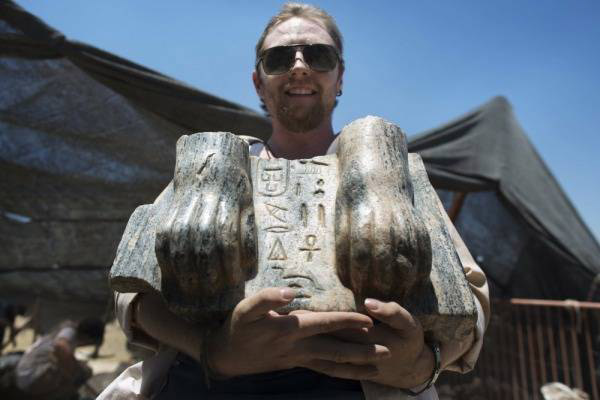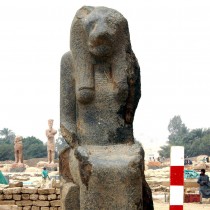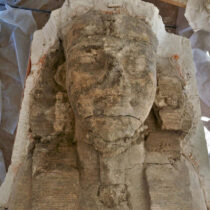The discovery of a partially surviving monumental statue of a sphinx that took place last August in Tel Hazor, Northern Israel, is still a riddle for archaeologists trying to figure out how it ended up there.
The 50 centimetres long broken granite sphinx statue -including the paws and some of the mythical creature’s forearms – now displayed at Tel Hazor archaeological site in Israel’s Galilee- , survives with an inscription with the king’s name and the characterization “beloved by the divine souls of Heliopolis”. It is estimated that originally its length might have reached 150 centimetres and its height was half a metre. It is the first known sphinx ascribed to Egyptian ruler Mycerinus, who ruled circa 2,500 B.C. and was builder of one of the three Giza pyramids. It is also the earliest piece of Pharaonic Egyptian monumental art ever found in the region.
“This is the only monumental Egyptian statue ever found in the Levant – today’s Israel, Lebanon, Syria,” says Amnon Ben-Tor, an archaeology professor at the Hebrew University in charge of the Tel Hazor dig. “It is also the only sphinx of this particular king known, not even in Egypt was a sphinx of that particular king found.”
Tel Hazor was the capital of southern Canaan, founded circa 2,700 BC and at its peak covering approximately 200 acres and home to some 20,000 Canaanites. It was destroyed in the 13th century BC. “Following a gap of some 150 years, it was resettled in the 11th century BC by the Israelites, who continuously occupied it until 732 BC,” when it was destroyed by the Asyrians, Ben-Tor said.
How, when and why it reached Tel Hazor remains a mystery.
“That it arrived in the days of Mycerinus himself is unlikely, since there were absolutely no relations between Egypt and this part of the world then […]. Egypt maintained relations with Lebanon, especially via the ancient port of Byblos, to import cedar wood via the Mediterranean, so they skipped today’s northern Israel”, states Ben-Tor.
Another option is that the statue was part of the plunders of the Canaanites, who in the late 17th and early 16th century BC ruled lower Egypt, the expert said. “Egyptian records tell us that those foreign rulers…plundered and desecrated the local temples and did all kinds of terrible things, and it is possible that some of this looting included a statue like this one.”
But to Ben-Tor the most likely way the sphinx reached Tel Hazor is in the form of a gift sent by a later Egyptian ruler.
“The third option is that it arrived in Hazor some time after the New Kingdom started in 1,550 BC, during which Egypt ruled Canaan, and maintained close relations with the local rulers, who were left on their thrones […]. In such a case it’s possible the statue was sent by the Egyptian ruler to king of Hazor, the most important ruler in this region.”
Ben-Dor said the statue was most likely deliberately broken by new occupiers at Tel Hazor in an act of defiance to the old rule.
Finding the sphinx was “unexpected,” said Ben-Tor, “but fits” archaeological facts and findings. However, according to him, the true coveted find would be archives buried somewhere on Tel Hazor that could serve as an inventory to the ancient city’s content.
“I know there are two archives,” he said. “We already have 18 documents from two periods, the 17th and 14th century BC. If I found those archives, people would come running here.”




